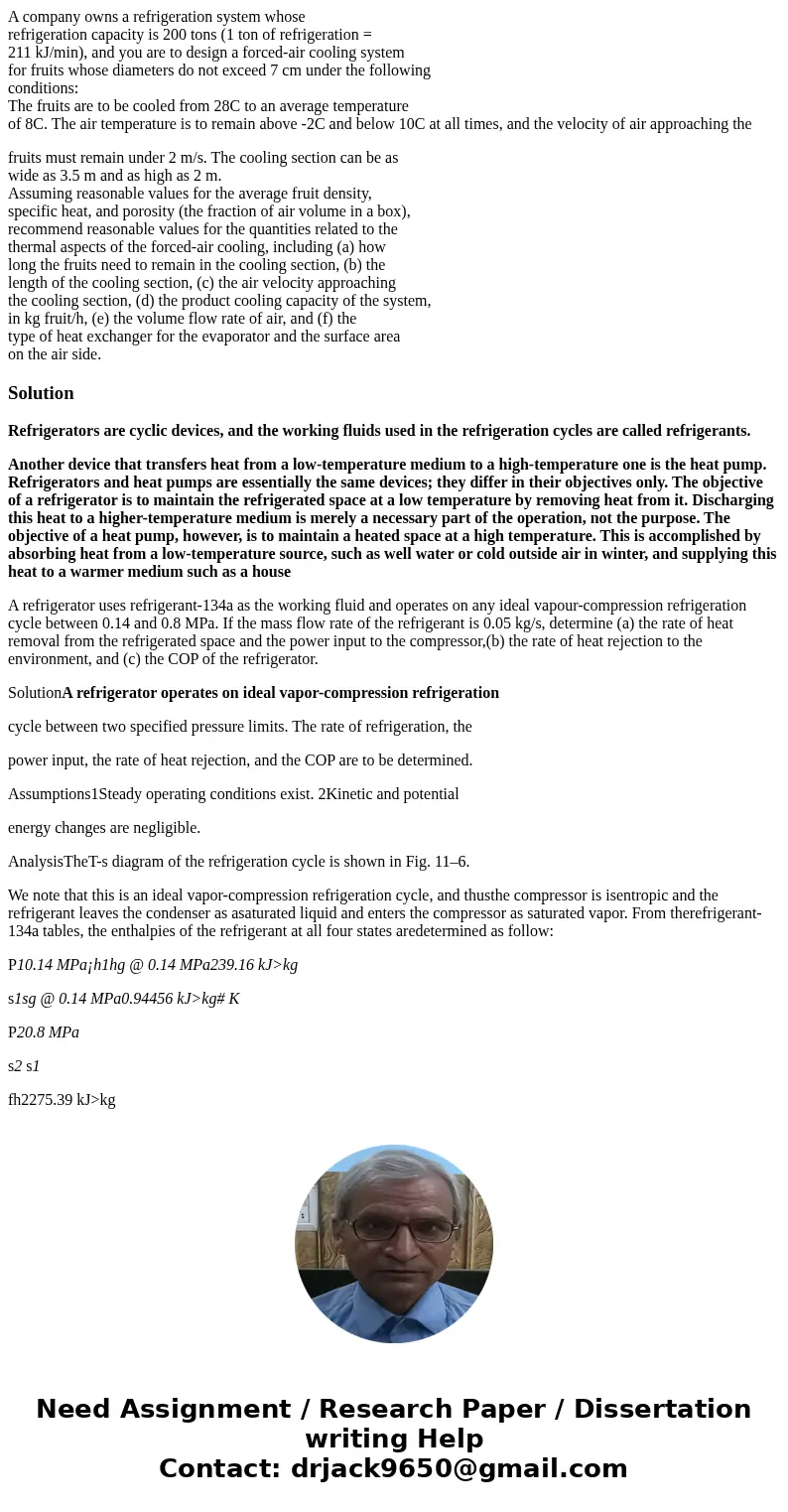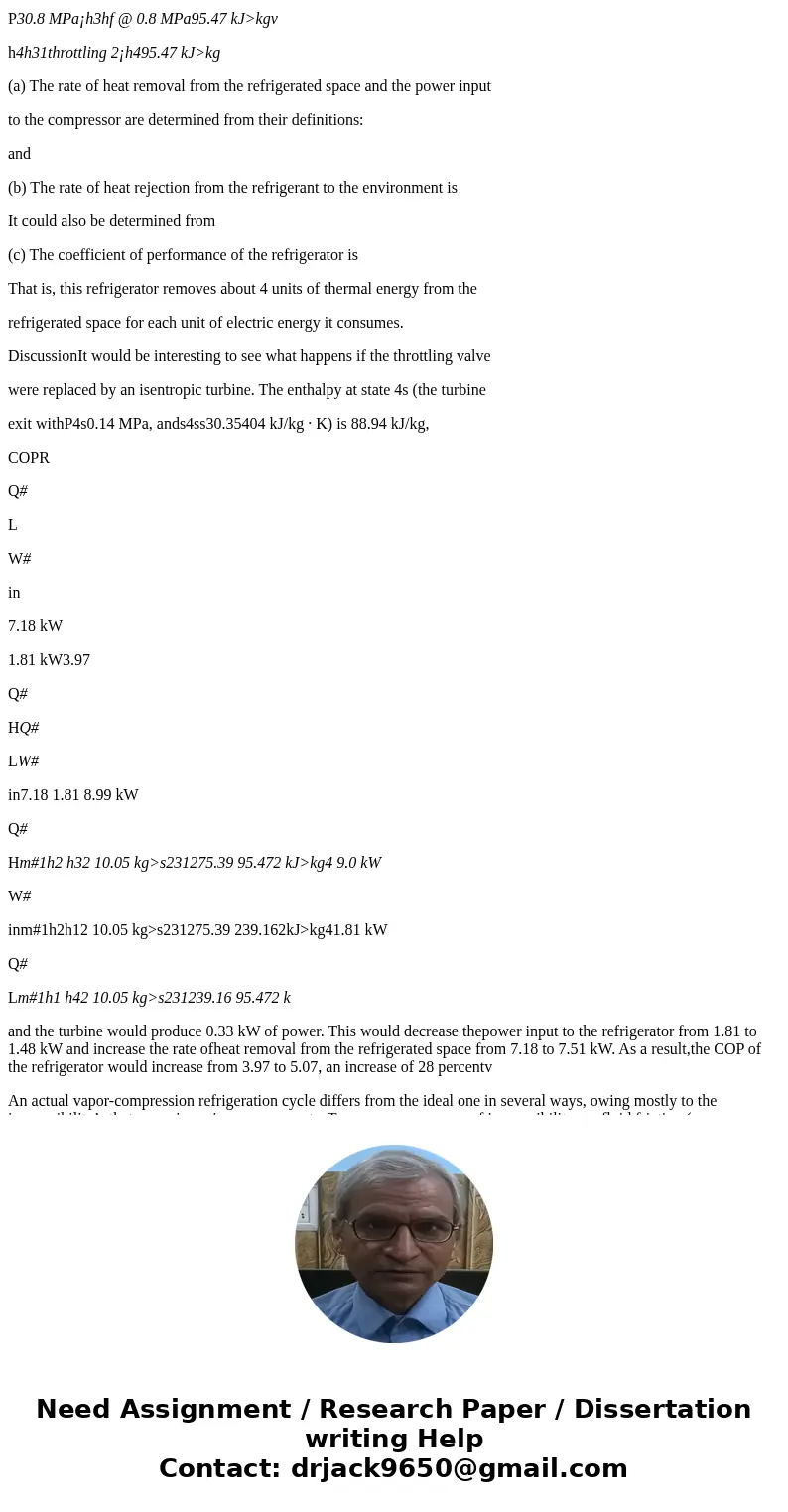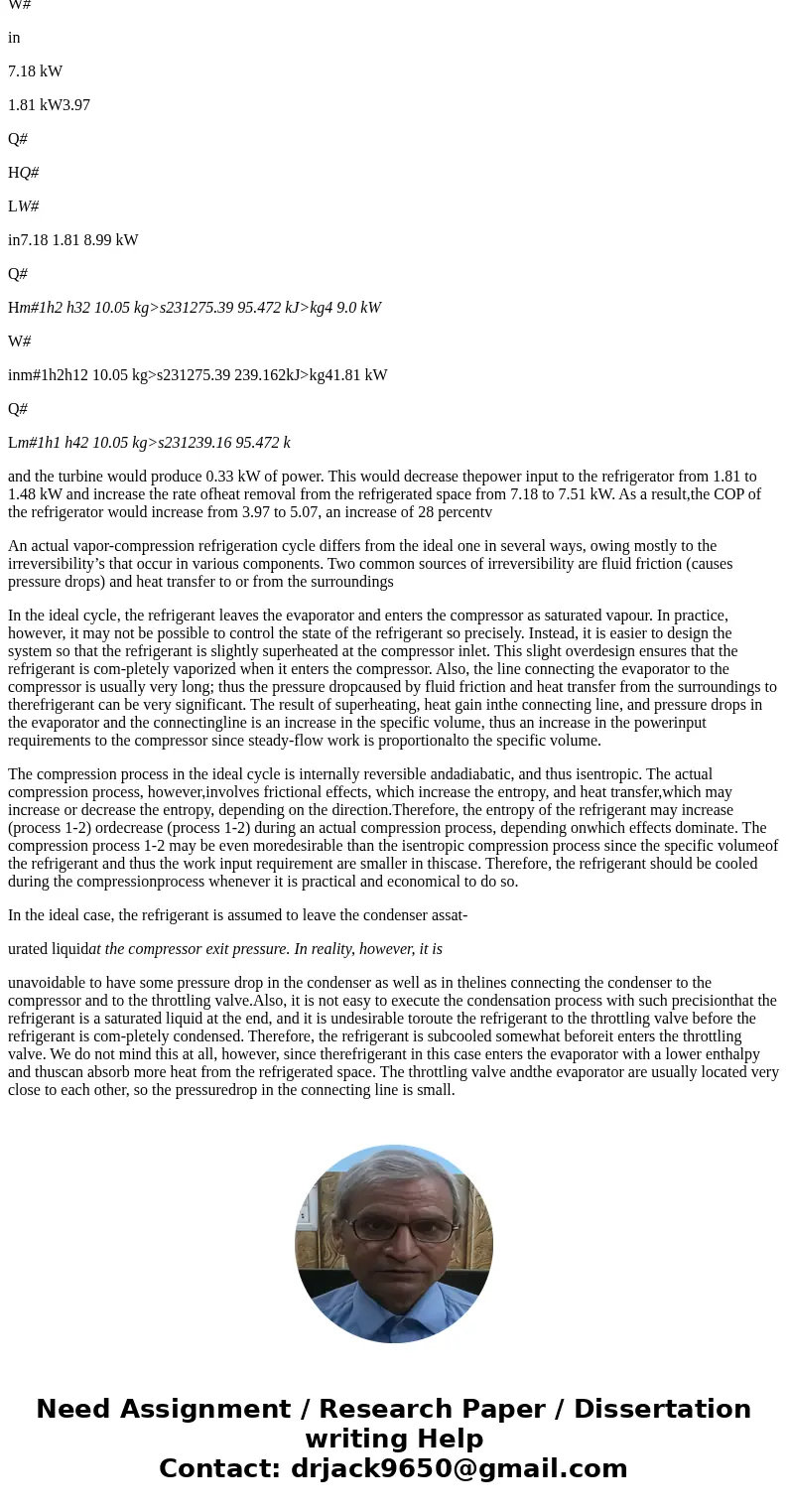A company owns a refrigeration system whose refrigeration ca
A company owns a refrigeration system whose
refrigeration capacity is 200 tons (1 ton of refrigeration =
211 kJ/min), and you are to design a forced-air cooling system
for fruits whose diameters do not exceed 7 cm under the following
conditions:
The fruits are to be cooled from 28C to an average temperature
of 8C. The air temperature is to remain above -2C and below 10C at all times, and the velocity of air approaching the
fruits must remain under 2 m/s. The cooling section can be as
wide as 3.5 m and as high as 2 m.
Assuming reasonable values for the average fruit density,
specific heat, and porosity (the fraction of air volume in a box),
recommend reasonable values for the quantities related to the
thermal aspects of the forced-air cooling, including (a) how
long the fruits need to remain in the cooling section, (b) the
length of the cooling section, (c) the air velocity approaching
the cooling section, (d) the product cooling capacity of the system,
in kg fruit/h, (e) the volume flow rate of air, and (f) the
type of heat exchanger for the evaporator and the surface area
on the air side.
Solution
Refrigerators are cyclic devices, and the working fluids used in the refrigeration cycles are called refrigerants.
Another device that transfers heat from a low-temperature medium to a high-temperature one is the heat pump. Refrigerators and heat pumps are essentially the same devices; they differ in their objectives only. The objective of a refrigerator is to maintain the refrigerated space at a low temperature by removing heat from it. Discharging this heat to a higher-temperature medium is merely a necessary part of the operation, not the purpose. The objective of a heat pump, however, is to maintain a heated space at a high temperature. This is accomplished by absorbing heat from a low-temperature source, such as well water or cold outside air in winter, and supplying this heat to a warmer medium such as a house
A refrigerator uses refrigerant-134a as the working fluid and operates on any ideal vapour-compression refrigeration cycle between 0.14 and 0.8 MPa. If the mass flow rate of the refrigerant is 0.05 kg/s, determine (a) the rate of heat removal from the refrigerated space and the power input to the compressor,(b) the rate of heat rejection to the environment, and (c) the COP of the refrigerator.
SolutionA refrigerator operates on ideal vapor-compression refrigeration
cycle between two specified pressure limits. The rate of refrigeration, the
power input, the rate of heat rejection, and the COP are to be determined.
Assumptions1Steady operating conditions exist. 2Kinetic and potential
energy changes are negligible.
AnalysisTheT-s diagram of the refrigeration cycle is shown in Fig. 11–6.
We note that this is an ideal vapor-compression refrigeration cycle, and thusthe compressor is isentropic and the refrigerant leaves the condenser as asaturated liquid and enters the compressor as saturated vapor. From therefrigerant-134a tables, the enthalpies of the refrigerant at all four states aredetermined as follow:
P10.14 MPa¡h1hg @ 0.14 MPa239.16 kJ>kg
s1sg @ 0.14 MPa0.94456 kJ>kg# K
P20.8 MPa
s2 s1
fh2275.39 kJ>kg
P30.8 MPa¡h3hf @ 0.8 MPa95.47 kJ>kgv
h4h31throttling 2¡h495.47 kJ>kg
(a) The rate of heat removal from the refrigerated space and the power input
to the compressor are determined from their definitions:
and
(b) The rate of heat rejection from the refrigerant to the environment is
It could also be determined from
(c) The coefficient of performance of the refrigerator is
That is, this refrigerator removes about 4 units of thermal energy from the
refrigerated space for each unit of electric energy it consumes.
DiscussionIt would be interesting to see what happens if the throttling valve
were replaced by an isentropic turbine. The enthalpy at state 4s (the turbine
exit withP4s0.14 MPa, ands4ss30.35404 kJ/kg · K) is 88.94 kJ/kg,
COPR
Q#
L
W#
in
7.18 kW
1.81 kW3.97
Q#
HQ#
LW#
in7.18 1.81 8.99 kW
Q#
Hm#1h2 h32 10.05 kg>s231275.39 95.472 kJ>kg4 9.0 kW
W#
inm#1h2h12 10.05 kg>s231275.39 239.162kJ>kg41.81 kW
Q#
Lm#1h1 h42 10.05 kg>s231239.16 95.472 k
and the turbine would produce 0.33 kW of power. This would decrease thepower input to the refrigerator from 1.81 to 1.48 kW and increase the rate ofheat removal from the refrigerated space from 7.18 to 7.51 kW. As a result,the COP of the refrigerator would increase from 3.97 to 5.07, an increase of 28 percentv
An actual vapor-compression refrigeration cycle differs from the ideal one in several ways, owing mostly to the irreversibility’s that occur in various components. Two common sources of irreversibility are fluid friction (causes pressure drops) and heat transfer to or from the surroundings
In the ideal cycle, the refrigerant leaves the evaporator and enters the compressor as saturated vapour. In practice, however, it may not be possible to control the state of the refrigerant so precisely. Instead, it is easier to design the system so that the refrigerant is slightly superheated at the compressor inlet. This slight overdesign ensures that the refrigerant is com-pletely vaporized when it enters the compressor. Also, the line connecting the evaporator to the compressor is usually very long; thus the pressure dropcaused by fluid friction and heat transfer from the surroundings to therefrigerant can be very significant. The result of superheating, heat gain inthe connecting line, and pressure drops in the evaporator and the connectingline is an increase in the specific volume, thus an increase in the powerinput requirements to the compressor since steady-flow work is proportionalto the specific volume.
The compression process in the ideal cycle is internally reversible andadiabatic, and thus isentropic. The actual compression process, however,involves frictional effects, which increase the entropy, and heat transfer,which may increase or decrease the entropy, depending on the direction.Therefore, the entropy of the refrigerant may increase (process 1-2) ordecrease (process 1-2) during an actual compression process, depending onwhich effects dominate. The compression process 1-2 may be even moredesirable than the isentropic compression process since the specific volumeof the refrigerant and thus the work input requirement are smaller in thiscase. Therefore, the refrigerant should be cooled during the compressionprocess whenever it is practical and economical to do so.
In the ideal case, the refrigerant is assumed to leave the condenser assat-
urated liquidat the compressor exit pressure. In reality, however, it is
unavoidable to have some pressure drop in the condenser as well as in thelines connecting the condenser to the compressor and to the throttling valve.Also, it is not easy to execute the condensation process with such precisionthat the refrigerant is a saturated liquid at the end, and it is undesirable toroute the refrigerant to the throttling valve before the refrigerant is com-pletely condensed. Therefore, the refrigerant is subcooled somewhat beforeit enters the throttling valve. We do not mind this at all, however, since therefrigerant in this case enters the evaporator with a lower enthalpy and thuscan absorb more heat from the refrigerated space. The throttling valve andthe evaporator are usually located very close to each other, so the pressuredrop in the connecting line is small.



 Homework Sourse
Homework Sourse